Microdosing Psilocybin and LSD: Panacea or Placebo?
May 02, 2024
by Aaron Salwan, PGY2 Psychiatric Pharmacy Resident
The psychedelic world is buzzing with talk about microdosing.
Claims and reports that it can enhance performance, treat mental illness, or even heal physical ailments abound. Public and industry excitement around microdosing is quickly increasing. Given microdoses lack characteristic and alterations to consciousness of psychedelics and can be used without the time commitment of larger doses, it is understandably an appealing option as a therapeutic alternative.
But is it all hype or is there genuine hope for therapeutic application of microdosing?
There’s certainly plenty of ‘conflicting’ information or results available from studies of different methodologies. Here, we begin with an overview of what microdosing is, who does it, and for what purposes. We then review available evidence and summarize benefits and risks of microdosing. Finally, we get more practical and discuss microdosing regimens, measurement of accurate dosing, and ‘set and setting’ consideration to microdosing.
What is Microdosing?
Microdosing psychedelics is a practice that involves frequently consuming low doses of psychedelics, primarily psilocybin or lysergic acid diethylamide (LSD). Microdosing has increased in the past decade, although anthropological evidence suggests use of low doses of psychedelics to increase stamina, improve hunting skills, or as aphrodisiacs has been a component of historical psychedelic use [1, 2].
Resurgence of interest in microdosing is commonly credited to James Fadiman, who published The Psychedelic Explorer Guide: Safe, Therapeutic, and Sacred Journeys in 2011[3]. A true microdose is ‘sub-perceptual’, meaning persons should not feel psychoactive effects, however persons that microdose commonly observe acute mood enhancing or other effects. Commonly reported doses for microdosing range from 5-20mcg LSD and 0.05-0.3g (50-300mg) dried psilocybin-containing mushrooms [4].
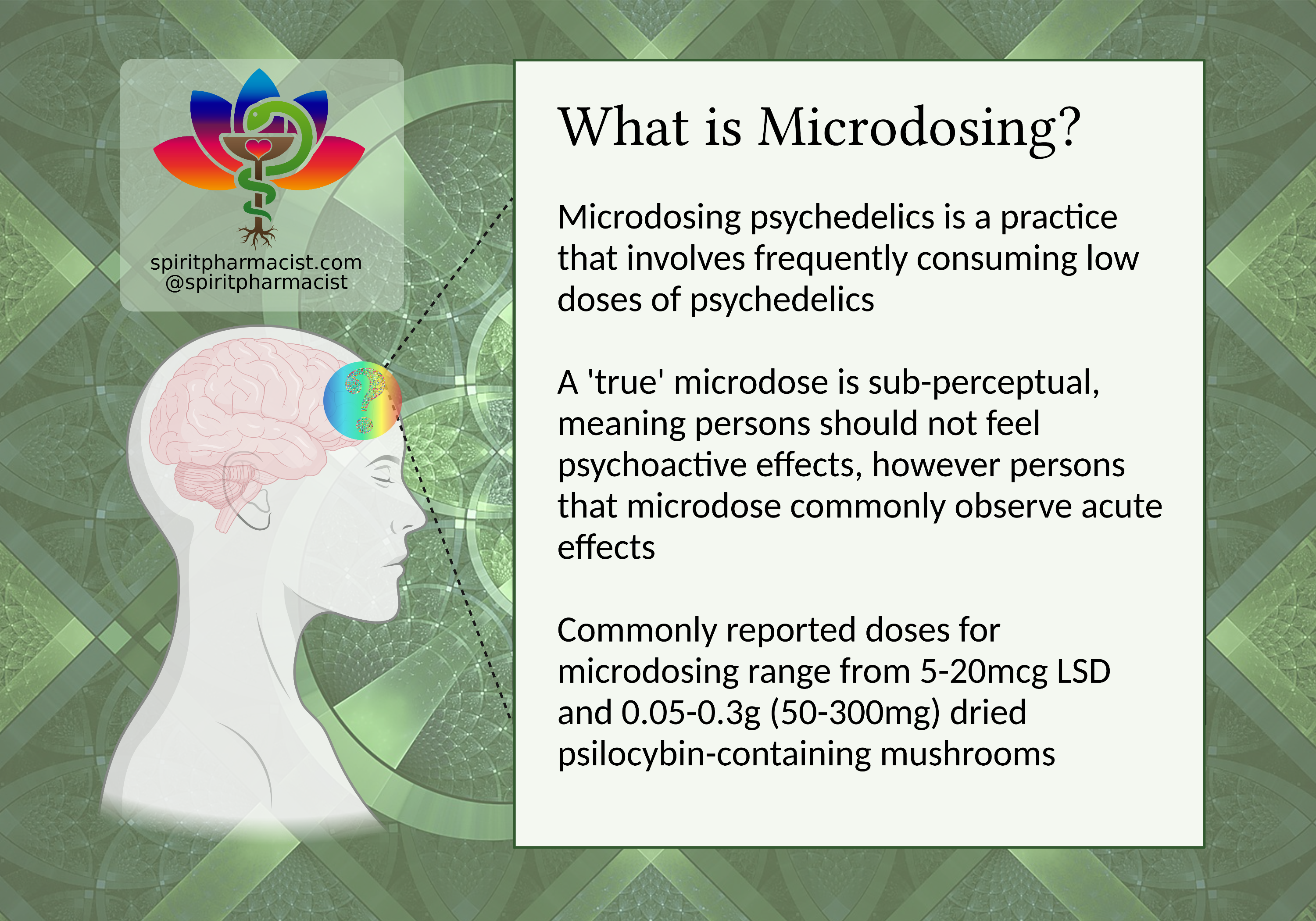
Why are People Microdosing?
There are many reasons why persons may attempt microdosing, although appears to be broadly divided into persons with psychiatric illness and ‘biohackers’.
Technology professionals in Silicon Valley popularized microdosing to enhance performance and creativity and perceive microdosing as a supplement to increase capacities beyond normal functioning (biohacking) [5-9]. At this stage, interest in microdosing for enhancing flexible cognition is increasing amongst college students as well as artists and musicians [10]. In an open-label study that compared creativity-related problem solving amongst people who consumed microdoses of psilocybin-containing truffles, microdoses led to improvements in divergent thinking. This means their ability to develop many possible solutions to a loosely defined problem was increased. However, the authors did not find an improvement in fluid intelligence, suggesting that microdosing may improve creativity but not general cognition [8, 9].
The other major population of persons currently experimenting with microdosing are those with psychiatric illnesses. For example, most persons who participated in studies of microdosing were living with depression, anxiety, or ADHD [11-13]. These illnesses are usually managed with serotonin reuptake blocking antidepressants (e.g. SSRIs), although these medications are not effective in 10-30% of persons or are accompanied by bothersome side effects, leading some to seek alternatives [14]. Moderate doses of psychedelics in clinically supervised settings (psychedelic-assisted psychotherapy) is accumulating substantial and solid evidence of benefit in several psychiatric conditions [15]. Persons may perceive microdosing as safer and more convenient than use of higher doses due to avoidance of extreme psychological effects associated with intense psychedelic experiences. However, the amount we know about safety and benefits of microdosing is relatively little compared to psychedelic-assisted psychotherapy. From available information it appears psychedelic assisted psychotherapies provide robust and clinically meaningful improvements with a large effect size whereas microdosing provides modest effects if any.
How Could Microdosing Produce Effects?
The serotonin receptors psychedelics like psilocybin and LSD interact with are found in tissues throughout the body, giving rise to questions about the underlying mechanisms that could be at play in microdosing or psychedelic therapies in general. For example, psychedelics have been found to have potent anti-inflammatory effects as well as affecting the human microbiome [16, 17]. In neural tissues psychedelics have neuroplastic or neuroregenerative effects, although one may wonder if microdoses reach these tissues or are capable of producing significant effects at such low concentrations [17, 18]. Anecdotes of improvement in auto-immune, physical, and neurological illnesses have occurred with psychedelics. Different mechanisms may be more prominent at different doses or administration regimens of psychedelics, which is generating interest in use of microdosing psychedelics for non-psychiatric applications [19, 20].
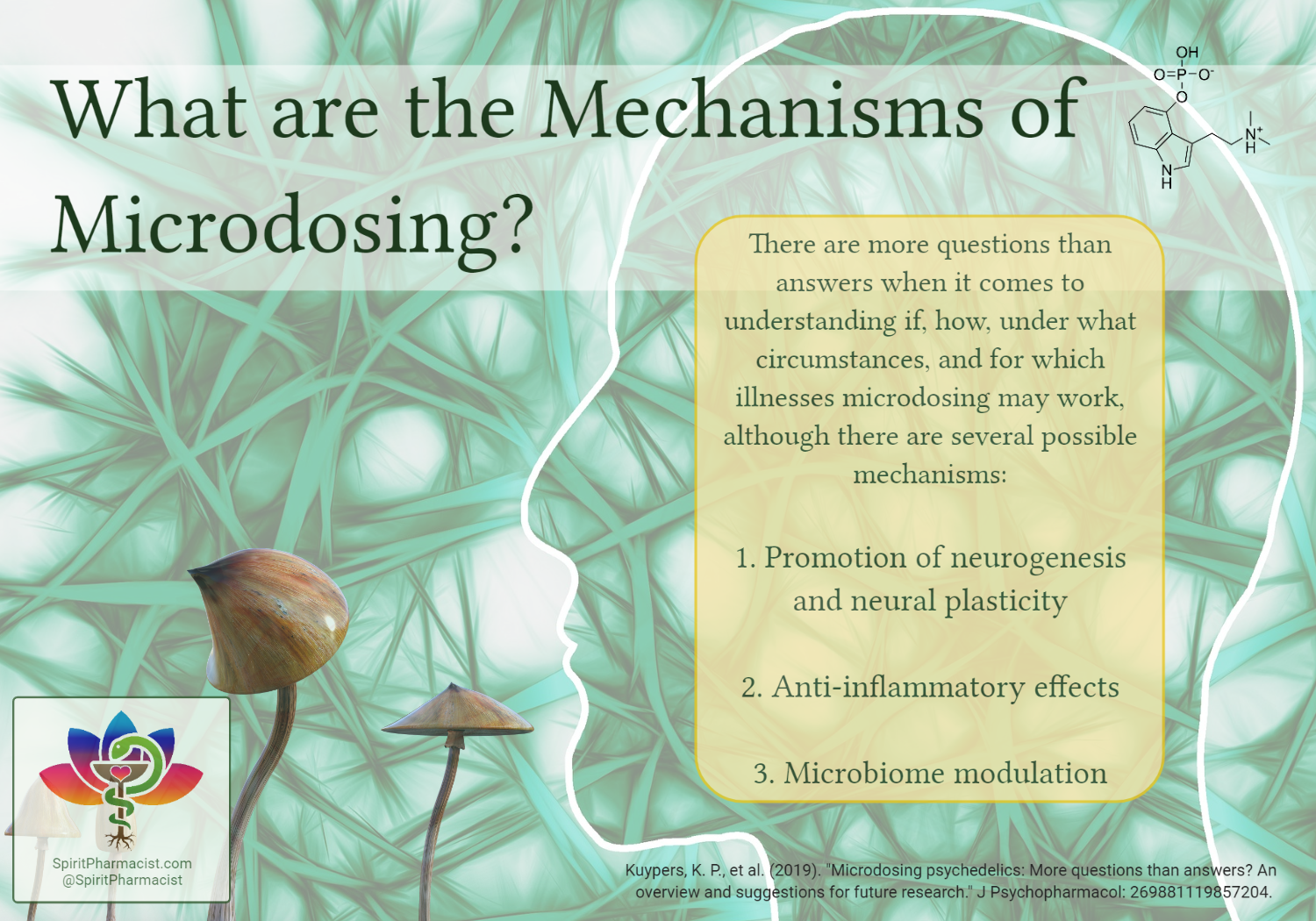
Does Microdosing Work?
Plainly put, the jury is still out as to whether microdosing ‘works’ or not and the answer could be dependent on the regimen of administration and purpose of use. Some research suggests benefits, other studies suggest placebo effects. Limited laboratory studies have demonstrated biological effects of microdosing, yet whether this translates into therapeutic benefits remains to be seen. Given the infancy of research with microdosing overall, it is expected that over time it will be revealed that microdosing has benefits for specific applications while being ineffective or even hazardous for others, although for now little can be said conclusively.
Observational Studies of Microdosing
A systematic review evaluating the safety and benefits of microdosing psychedelics, including both observational and experimental studies, identified some trends in available data [21]. The observational studies primarily consisted of online surveys. People in these studies report microdosing with LSD or psilocybin improved symptoms of depression, anxiety, PTSD, and ADHD [22, 23] and that psychedelics were better tolerated and more effective than conventional treatments [2, 6, 11]. Along with improvements in mood and cognition, persons who microdose also reported improvement in health conditions such as pain severity and cluster headaches [10, 24]. Participants also reported a reduction in substance use, including caffeine, cannabis, alcohol, and tobacco [2, 25]. A large case series documenting anecdotes of persons that microdosed have even reported unexpected improvements in physical or neurological illnesses, such as migraine headaches, pre-menstrual symptoms, traumatic brain injury, and shingles amongst other conditions [26]. However, these studies are often limited to surveys or user reports, do not feature placebo or control groups, and are largely composed of participants recruited from forums frequented by psychedelic enthusiasts, which can increase risks of bias or distort results. These preliminary observational studies of microdosing are important because it could identify promising applications for microdosing psychedelics, although is best taken with a serious grain of salt.
Laboratory and Clinical Studies of Microdosing
A clinical trial exploring the subjective effects of small doses of LSD on twenty healthy volunteers found that 6.5mcg, 13mcg, or 26mcg of LSD neither improved mood or divergent thinking [27]. Another study was able to identify a delay in participants time perception after receiving microdoses of LSD in the absence of subjective alterations of consciousness [28]. This finding is significant because it demonstrates that LSD has pharmacological effects at low doses without causing psychoactive effects. In a double-blind, placebo-controlled, randomized study of the effects of 5mcg, 10mcg, or 20mcg of LSD every four days for 21 days, there were no observable changes in cognition detected [29]. Interestingly, they did find a positive linear relationship between dose and vigilance reduction based on ratings from the 5-Dimensional Altered States of Consciousness Rating Scale (5D-ASC). This scale is frequently used to characterize the subjective effects of various psychedellics [30-32]. Statements related to a reduction in vigilance included “My thoughts and actions were slowed down” and “I felt sleepy”. Laboratory studies have also revealed physiological effects at low doses as it was found just 13mcg of LSD was enough to increase blood pressure [27, 33].
Could Microdosing be a Placebo?
As the majority of data on the benefits of microdosing lacks a control group, the results could be explained by placebo effects. A recent study that employed novel self-blinding methodology instructed participants how to blind themselves by incorporating control doses into their normal microdosing routine [34]. The results were suggestive of the placebo effect. The authors found that participants only experienced benefits from microdosing when they believed they had taken a microdose, regardless of ingesting the active drug or a placebo. Taking an actual microdose only altered ratings on the drug intensity scale which manifested as body and perceptual sensations [34]. This means that participants could truly sense some effects of taking a microdose, although these effects were not relevant to therapeutically oriented outcomes.
Is Microdosing Safe?
Microdosing may have a perception of being safer than using full doses of psychedelic substances due to the lack of intense psychological effects characteristic of larger doses. However, it is unknown if microdosing psychedelics in a semi-chronic manner could carry physical or psychological risks as it is not a manner of psychedelic use that has been prevalent or studied in the past. The use of psychedelics amongst persons experiencing mental illness may carry unique risks compared to persons using psychedelics for ‘biohacking’ purposes. Like effectiveness, the jury is still out as to whether microdosing is ‘safe’ or not.
Side Effects of Microdosing
Participants experienced a variety of psychological side effects from microdosing. Adverse events reported included negative effects on mood (increased anxiety, sadness, irritability, worsening of depression), physical discomfort, cognitive impairment, insomnia, and impaired social skills [21]. One study also identified an increased incidence of headaches in those receiving LSD compared to placebo [29]. Insomnia and anxiety were the most frequently reported adverse effects, potentially related to ingesting too large of a dose. In clinical trials, it was found that participants who received 26mcg LSD, but not lower doses, experienced an increase in anxiety. These results were replicated in a different study conducted by the same authors.
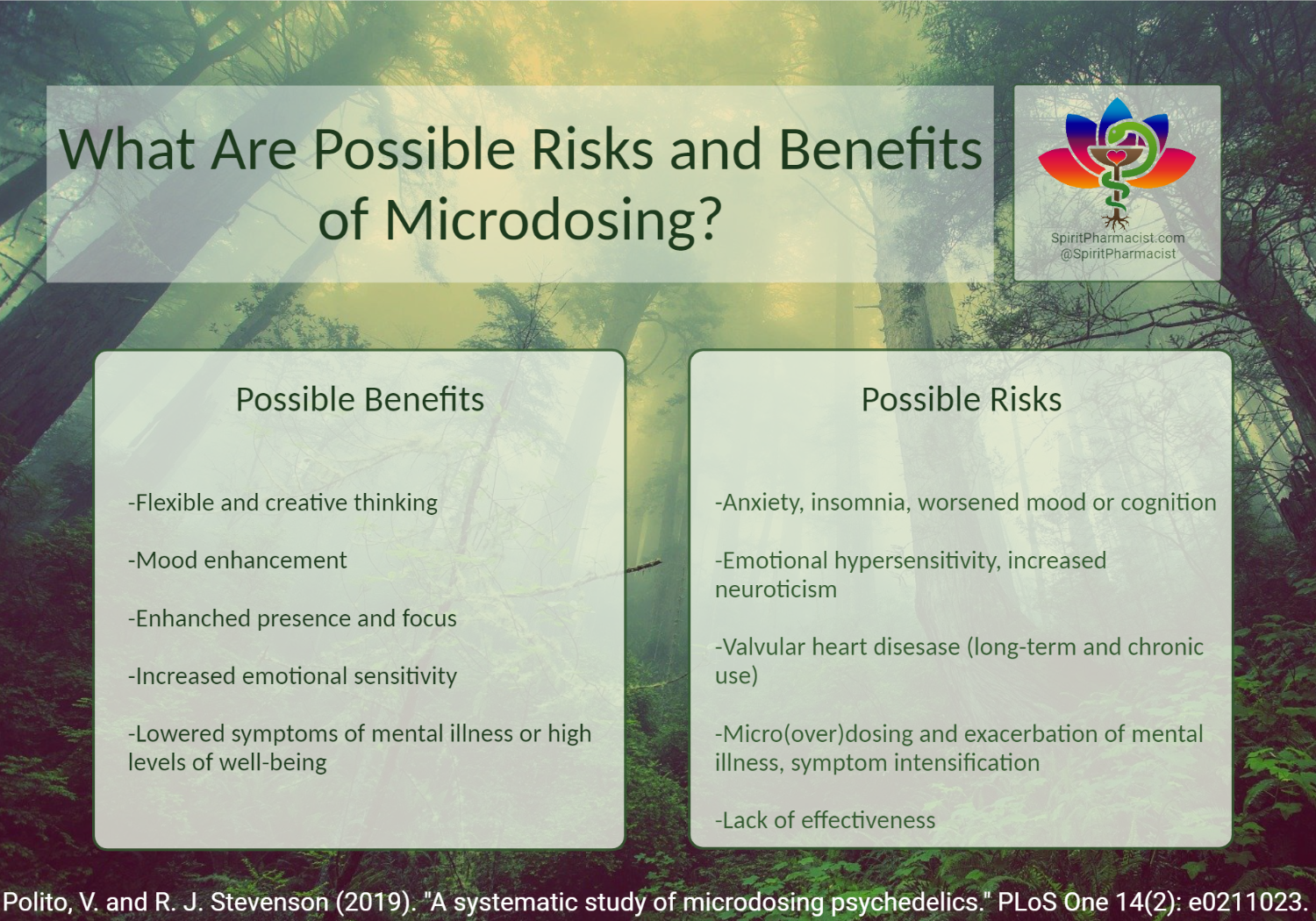
Long Term Safety of Microdosing
Long term side effects associated with microdosing are not currently understood and studies have been limited to weeks in duration so far. However, it is possible that continuous exposure to psychedelics like psilocybin or LSD which can stimulate 5HT2B receptors pose an increased risk for valvular heart disease [35]. Common symptoms of valvular heart disease include shortness of breath, chest pain, fatigue, rapid weight gain, or irregular heartbeat. Previous pharmacological options for weight loss acting on these receptors were withdrawn from the market as nearly 25% of patients taking these medications daily developed valvular heart disease [36]. Worsened control of hypertension has not been reported in studies to date, although low doses of LSD (13 mcg) can increase blood pressures, which could carry safety implications for persons with cardiovascular illnesses [27, 33].
Considerations for Microdosing
It is hard to know ‘how to microdose?’ or ‘which microdosing regimen is best?’ at this point in time. There are certainly aspects of therapeutic microdosing that can be borrowed from psychedelic assisted psychotherapy that could enhance safety or benefit, and some reasonable cautions can minimize risks of psychological or physical harm. We’ll cover some practical questions and considerations one may consider when approaching microdosing now.
Set, Setting, and Microdosing
An integral component of safe and beneficial use of psychedelic substances involves an appropriate ‘set and setting’ or mindset to approach the experience and comfortable, safe, and supportive environment. Compared to psychedelic-assisted psychotherapy, discussions of set and setting are not as common with microdosing, although could contribute to success or failure.
Psychedelic use is associated with neuroplastic brain states, increased openness, and increased sensitivity to environmental stimuli. These effects may be subtle, yet considerable, to persons microdosing. For example, one study found that despite reported decreases in depression and anxiety after six weeks of microdosing, that neuroticism was increased [37]. While some persons may benefit from enhancement in emotional sensitivity or make lifestyle changes in response to enhanced emotional awareness, others may experience negative effects of intensified emotion. This could be particularly important to consider in persons with psychiatric illnesses or those with significant stressors present in their environment. Consideration of ‘set and setting’ and accompanying a microdosing regimen with therapeutic support, particularly if attempting treatment of a mental illness, is an important harm reduction measure.
What are Regimens for Microdosing?
A few regimens for microdosing are commonly known and used, while others (e.g., IV infusion of microdose DMT) are being developed for specific applications. Currently, there is no good information to understand which regimen is best or safest. While some people microdose on an almost daily basis, taking a few days off between microdoses is thought to reduce the likelihood of developing tolerance. Persons may be meticulous about microdosing and follow a protocol or vary doses or times between uses.
The most well-known regimen for microdosing is known as the ‘Fadiman protocol’ and suggests taking 5-10% of a full dose of a psychedelic every 3 to 4 days, which equals ~10-13mcgs of LSD or 0.1-0.3g of dried psilocybin-containing mushrooms [4].
Another common regimen is named the ‘Stamets protocol’ after mycologist Paul Stamets, who suggests using microdoses of psilocybin mushrooms (0.1-1g) in conjunction with lion’s mane (50-200mg) and niacin (100-200mg) for 5 days on and 2 days off.
Due to concerns with long-term safety, it could be beneficial to limit microdosing to a course of 1-2 months and take breaks of similar time frames for observation after a course until better safety information is available.
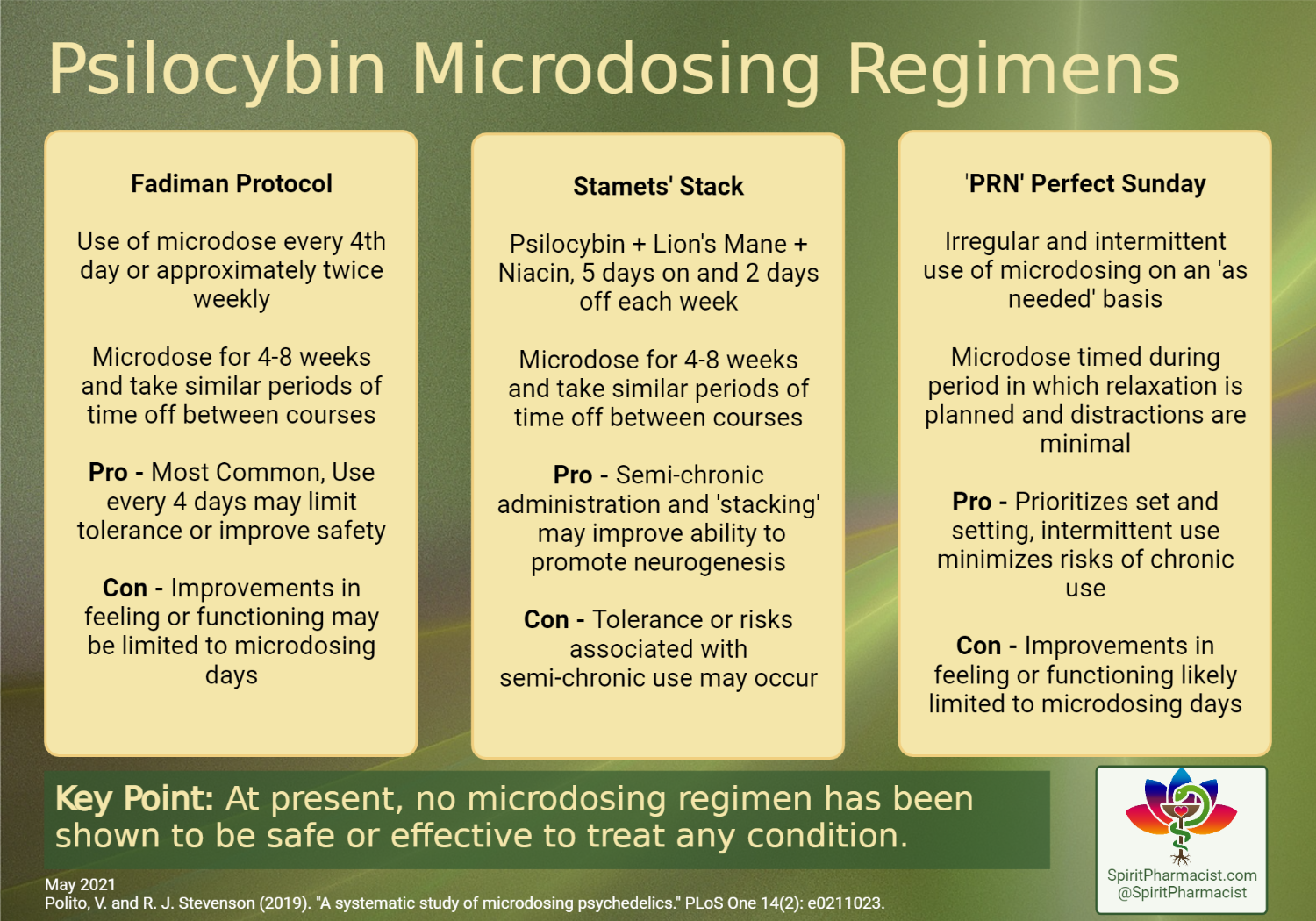
Can you Microdose PRN or ‘as needed’?
One study followed participants for six weeks and completed brief daily rating scales that recorded if they microdosed that day, substance / dose, and feelings of connectedness, contemplation, creativity, focus, happiness, productiveness, and wellbeing. Results of this study indicated that microdosing led to an improvement across all psychological function measures compared to baseline scores [37]. Interestingly, benefits that resulted from microdosing were not maintained in the days following dose consumption. This could indicate a placebo effect or benefits that were limited to days a microdose was ingested. If the latter were true, it appears a more flexible approach to microdosing may also have value and could minimize risks associated with semi-chronic use.
How Can Accurate Microdoses be Prepared?
One aspect of microdosing that is potentially problematic is the accurate measurement of low doses of psychedelics. Available research suggests that overshooting a microdose can produce side effects such as increased anxiety and anecdotes have reported unwanted psychedelic effects from taking too large of a microdose. Due to the variability in psilocybin concentrations amongst mushrooms there is potential for variation in amounts of psilocybin present in dried mushrooms. Due to the microgram potency of LSD, it is typically found dosed on blotter paper or as a concentrated liquid solution. Difficulty measuring small amounts of liquid or cutting blotter into pieces small enough to be microdoses creates potential for over(micro)doses to occur.
Dried psilocybin containing mushrooms can be placed in a clean coffee grinder to break them down, which can help homogenize psilocybin concentrations amongst the resulting course powder. Using a scale accurate to a milligram (e.g., jewelry scale), doses of desired weights of the psilocybin mushroom powder (0.05-0.3g) can be placed within capsules. Smaller capsules of 50mg (0.05g) or 100mg (0.1g) allows flexibility in dosing and the ability to start at minimum doses.
Liquid LSD of known strength (e.g., 2mg/ml or ~100mcg per drop) or LSD on blotter (e.g., 100mcg per tab) can be diluted volumetrically in a liquid such as distilled water. Ten tabs (100mcg/tab) in 10mls or 10 drops containing (100mcg per drop) in 9.5ml of distilled water would create a solution containing 10mcg of LSD per 0.1ml. Accuracy of dosing can be improved with a graded 1ml oral syringe. LSD is sensitive to light, thus glass amber vials are ideal for storage. Mixing well prior to each use by gently rolling the vial or squeezing the dropper several times can help ensure the strength is consistent.
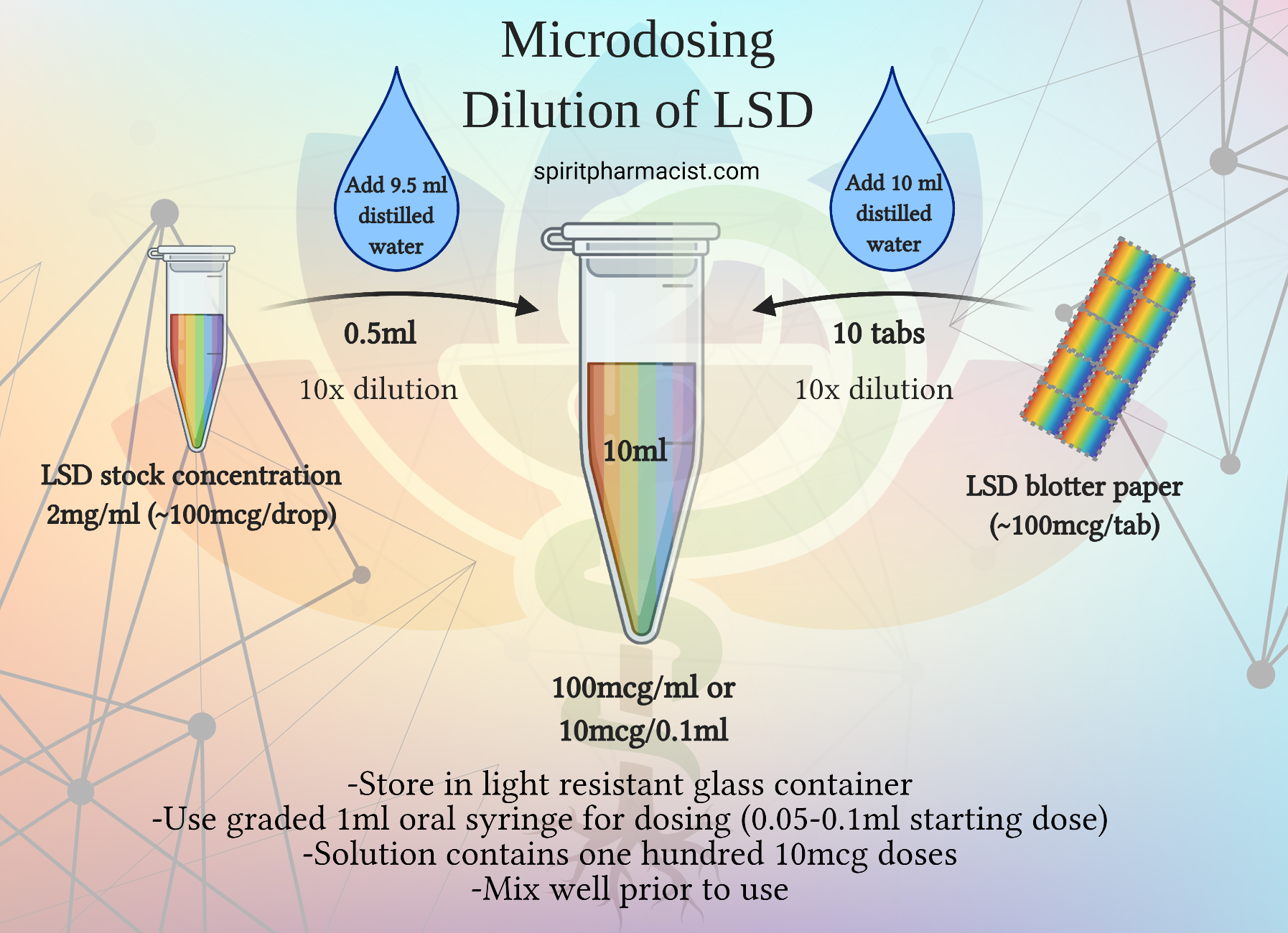
Is it Dangerous to Microdose while Taking Antidepressants (SSRIs)?
Currently, there is not any research that explores the safety and efficacy of microdosing while concurrently taking a serotonin reuptake blocking antidepressants (e.g., SSRIs, SNRIs). Based on the pharmacology of psilocybin and LSD, significant physical harm is unlikely from their combination. People who use full doses of LSD and psilocybin while taking a SSRI often report diminished psychedelic effects,[38] leading some to think microdosing would be ineffective. However, some users report positive effects of microdosing while taking antidepressants and respond to larger doses of psilocybin while taking them. Of note, it is not safe to microdose ayahuasca or harmala alkaloids with SSRIs/SNRIs.
Microsummary and Conclusion
There is much to be learned about how microdoses of psychedelics may work and under what circumstances or for which applications they have favorable risk and benefit profiles.
The current evidence that microdosing improves mood and mental health conditions is weak compared with psychedelic-assisted psychotherapy. However, thousands of people report benefits and microdoses have had some physical and perceptual changes detected in laboratory studies. Microdoses are reported as generally well tolerated, although side effects such as anxiety and insomnia commonly occur [21, 29]. Consideration of ‘set and setting’, getting additional help and support, limiting courses to two months as well as starting with minimal doses in safe comfortable environments are reasonable measures to improve safety in persons choosing to microdose psychedelics.
References
- Horowitz, M., Interview With Albert Hoffman. 1976: High Times. p. 11.
- Anderson, T., et al., Psychedelic microdosing benefits and challenges: an empirical codebook. Harm Reduction Journal, 2019. 16(1).
- Fadiman, J., The Psychedelic Explorer Guide: Safe, Therapeutic, and Sacred Journeys. 2011, Park Street Press: Rochester, VT.
- Schirp, M., Microdosing: The Revolutionary Way of Using Psychedelics. 2015.
- Dean, J., Micro-dosing: The Drug Habit Your Boss Is Gonna Love. 2017, GQ.
- Webb, M., H. Copes, and P.S. Hendricks, Narrative identity, rationality, and microdosing classic psychedelics. International Journal of Drug Policy, 2019. 70: p. 33-39.
- Marinkovic, M., Microdosing Psychedelics: Biohack or Placebo? 2020.
- Guilford, J., The nature of human intelligence. 1967, McGraw-Hill: New York.
- Prochazkova, L., et al., Exploring the effect of microdosing psychedelics on creativity in an open-label natural setting. Psychopharmacology, 2018. 235(12): p. 3401-3413.
- Andersson, M. and A. Kjellgren, Twenty percent better with 20 micrograms? A qualitative study of psychedelic microdosing self-rapports and discussions on YouTube. Harm Reduction Journal, 2019. 16(1).
- Hutten, N.R.P.W., et al., Self-Rated Effectiveness of Microdosing With Psychedelics for Mental and Physical Health Problems Among Microdosers. Frontiers in Psychiatry, 2019. 10.
- Kaertner, L.S., et al., Positive expectations predict improved mental-health outcomes linked to psychedelic microdosing. Scientific Reports, 2021. 11(1).
- Rosenbaum, D., et al., Microdosing psychedelics: Demographics, practices, and psychiatric comorbidities. Journal of Psychopharmacology, 2020. 34(6): p. 612-622.
- Al-Harbi, Treatment-resistant depression: therapeutic trends, challenges, and future directions. Patient Preference and Adherence, 2012: p. 369.
- Luoma, J.B., et al., A Meta-Analysis of Placebo-Controlled Trials of Psychedelic-Assisted Therapy. Journal of Psychoactive Drugs, 2020. 52(4): p. 289-299.
- Szabo, A., Psychedelics and Immunomodulation: Novel Approaches and Therapeutic Opportunities. Frontiers in Immunology, 2015. 6.
- Kuypers, K.P.C., Psychedelic medicine: The biology underlying the persisting psychedelic effects. Medical Hypotheses, 2019. 125: p. 21-24.
- Olson, D.E., Psychoplastogens: A Promising Class of Plasticity-Promoting Neurotherapeutics. Journal of Experimental Neuroscience, 2018. 12: p. 117906951880050.
- Pharmaceuticals, A., Algernon Pharmaceuticals Launches Stroke Treatment Clinical Research Program with Psychedelic Drug DMT “The Spirit Molecule”. 2021: Intrado GlobeNewswire.
- Vann Jones, S.A. and A. O'Kelly, Psychedelics as a Treatment for Alzheimer's Disease Dementia. Front Synaptic Neurosci, 2020. 12: p. 34.
- Ona, G. and J.C. Bouso, Potential safety, benefits, and influence of the placebo effect in microdosing psychedelic drugs: A systematic review. Neuroscience & Biobehavioral Reviews, 2020. 119: p. 194-203.
- Cameron, L.P., A. Nazarian, and D.E. Olson, Psychedelic Microdosing: Prevalence and Subjective Effects. J Psychoactive Drugs, 2020. 52(2): p. 113-122.
- Lea, T., et al., Microdosing psychedelics: Motivations, subjective effects and harm reduction. International Journal of Drug Policy, 2020. 75: p. 102600.
- Johnstad, P.G., Powerful substances in tiny amounts. Nordic Studies on Alcohol and Drugs, 2018. 35(1): p. 39-51.
- Lea, T., et al., Perceived outcomes of psychedelic microdosing as self-managed therapies for mental and substance use disorders. Psychopharmacology, 2020. 237(5): p. 1521-1532.
- Fadiman, J. and S. Korb, Might Microdosing Psychedelics Be Safe and Beneficial? An Initial Exploration. J Psychoactive Drugs, 2019. 51(2): p. 118-122.
- Bershad, A.K., et al., Acute Subjective and Behavioral Effects of Microdoses of Lysergic Acid Diethylamide in Healthy Human Volunteers. Biol Psychiatry, 2019. 86(10): p. 792-800.
- Yanakieva, S., et al., The effects of microdose LSD on time perception: a randomised, double-blind, placebo-controlled trial. Psychopharmacology, 2019. 236(4): p. 1159-1170.
- Family, N., et al., Safety, tolerability, pharmacokinetics, and pharmacodynamics of low dose lysergic acid diethylamide (LSD) in healthy older volunteers. Psychopharmacology, 2020. 237(3): p. 841-853.
- Schmid, Y., et al., Acute Effects of Lysergic Acid Diethylamide in Healthy Subjects. Biological Psychiatry, 2015. 78(8): p. 544-553.
- Hasler, F., et al., Acute psychological and physiological effects of psilocybin in healthy humans: a double-blind, placebo-controlled dose?effect study. Psychopharmacology, 2004. 172(2): p. 145-156.
- Hysek, C.M., et al., The Norepinephrine Transporter Inhibitor Reboxetine Reduces Stimulant Effects of MDMA (“Ecstasy”) in Humans. Clinical Pharmacology & Therapeutics, 2011. 90(2): p. 246-255.
- Bershad, A.K., et al., Preliminary Report on the Effects of a Low Dose of LSD on Resting-State Amygdala Functional Connectivity. Biol Psychiatry Cogn Neurosci Neuroimaging, 2020. 5(4): p. 461-467.
- Szigeti, B., et al., Self-blinding citizen science to explore psychedelic microdosing. eLife, 2021. 10.
- Thomas, K., Why Chronic Microdosing Might Break Your Heart. 2019.
- Hutcheson, J.D., et al., Serotonin receptors and heart valve disease—It was meant 2B. Pharmacology & Therapeutics, 2011. 132(2): p. 146-157.
- Polito, V. and R.J. Stevenson, A systematic study of microdosing psychedelics. PLOS ONE, 2019. 14(2): p. e0211023.
- Bonson, K., Chronic Administration of Serotonergic Antidepressants Attenuates the Subjective Effects of LSD in Humans. Neuropsychopharmacology, 1996. 14(6): p. 425-436.
Join the Spirit Pharmacist Mailing List
Stay in touch to receive updates on new blogs, courses, special offers, and more. Don't worry, your information will not be shared.








